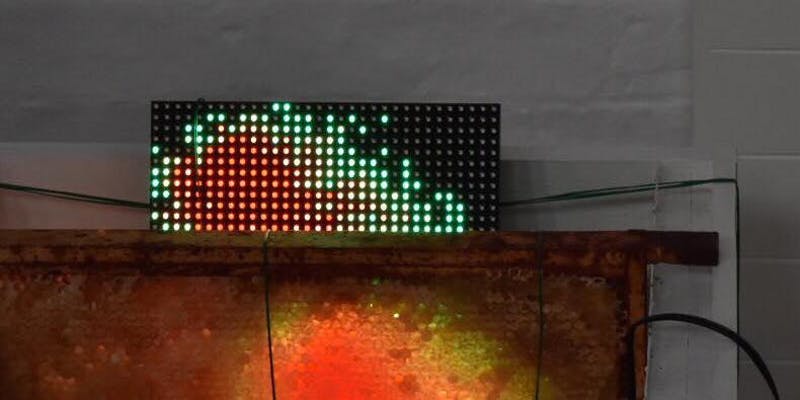Claire Frampton, an alumna of MA Arts Policy and Management, Birkbeck College, 2013 shares her experience attending the immersive performance presented by Lily Hunter-Green, artist in residence, School of Arts, Birkbeck.
The work Silencing the Virus explored the threat to bees from diseases, specifically Israeli Acute Paralysis Virus, in an immersive interactive digital experience that took place in Birkbeck School of Arts. I walked into the gallery and saw white jumpsuits hanging from the ceiling, with some headwear that resembled beekeepers’ hat and veil. This introduced themes of interaction with nature, the jumpsuits created an atmosphere of an environment in which humans would need protection from infection. On the floor yellow and black tape marked out an area where the main action of the interactive performance took place, like a quarantine area. An information panel on the wall set out the definitions of this project; ´infectious composition, contagious performance, ground breaking performance, eusocial experimentˋ. It described the context of the installation as evoking ´the disturbing dystopian world of a beehive under attackˋ from the virus, ´which is decimating honeybee colonies globallyˋ. A video on a small screen part of the installation explained in more depth, and included footage of bees illustrating the subject of the project.
In the first part of the presentation, audience members watched a film on a big screen which described the experience of artist Lily Hunter-Green working on her practice at a residency at The Gurdon Institute, the University of Cambridge where she was invited to work with molecular biologists. The video also included an explanation of the specific virus and the threat to the bee community by molecular biologist Dr. Eyal Maori. The tone of the video expressed the serious nature of the inspiration of the piece.
In the next part of the piece, audience members were given headphones and experienced music composed by Lily Hunter-Green and violinist Tom Moore, like a silent disco experience. Hunter-Green informed us that one participant, patient zero, infected the others. Participants held devices which vibrated, mimicking the sounds of bees, a small screen part of the device displayed computer code, highlighting the digital element. Hunter-Green had conducted experiments working with a computer scienctist who had written a code which infected music with a virus. The sound involved instruments playing music, and the introduction of buzzing sounds which took over. Participants walked around each other in the confined space, a bit like bees in a hive, having time to contemplate the installations. I was excited by innovation and how the project combined elements of nature and computerised music. The installation also included an interactive sound sculpture that demonstrated the spread of a virus through a beehive with changes of green and red lights.
The different elements of this work demonstrated exploration of creativity surrounding this topic and raised awareness of the threat to bees through disease. After the experience I felt I had better knowledge of this topic and a memorable experience. Listening to music on headphones had similarities to everyday experiences in the contemporary world, the infection element an interesting twist on the usual modern experience of listening to digitally stored music.
More information is available on Hunter-Greens’ website, which describes phases in history of her project.
